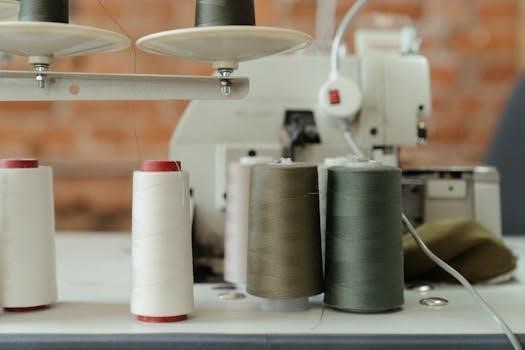Waffle Maker Instructions⁚ A Comprehensive Guide
Embark on a delightful journey into the world of homemade waffles with our comprehensive guide. From seasoned pros to waffle-making novices, this resource provides clear, step-by-step instructions for achieving golden, fluffy perfection; Learn how to master your waffle maker and create delicious waffles every time, ensuring a delightful breakfast or brunch experience.
Initial Setup and Preparation
Before embarking on your waffle-making adventure, proper initial setup and preparation are crucial for optimal results and safety. Begin by carefully unpacking your waffle maker, removing all packaging materials, and inspecting it for any damage incurred during shipping. Consult the manufacturer’s manual for specific instructions and safety guidelines pertaining to your model.
Next, clean the waffle maker’s housing and baking plates with a damp cloth to remove any dust or residue accumulated during manufacturing or storage. Ensure the plates are securely attached, following the manufacturer’s instructions for safe removal and reattachment if applicable. Select a stable, heat-resistant surface for operating the waffle maker, ensuring adequate ventilation around the appliance.
Before the first use, it’s advisable to “season” the non-stick grids. Lightly coat the grids with cooking spray or flavorless vegetable oil to enhance their non-stick properties and prevent waffles from sticking. This initial seasoning helps create a barrier between the batter and the metal, ensuring easy release and effortless cleanup.
Finally, familiarize yourself with the waffle maker’s controls and features, such as the browning control settings and indicator lights. Understanding these functions will allow you to customize your waffles to your desired level of crispness and ensure consistent results every time.
First Use⁚ Seasoning the Grids
Seasoning the grids of your new waffle maker is an essential step before the first use, ensuring optimal non-stick performance and preventing waffles from sticking. This process creates a protective layer, making it easier to release waffles and simplifying cleanup.
Begin by ensuring the waffle maker is unplugged and completely cool. Using a clean cloth or paper towel, lightly coat both the top and bottom grids with cooking spray or flavorless vegetable oil. Be sure to cover all surfaces of the grids, including any crevices or patterns. Avoid using excessive oil, as this can lead to uneven cooking and potential smoking.
Once the grids are coated, plug in the waffle maker and turn it on, setting it to a medium heat setting. Allow the waffle maker to heat up for several minutes, until the indicator light signals that it’s ready. During this process, you may notice a slight odor or smoke, which is normal as the oil heats up and bonds to the grids.
After the initial heating, turn off the waffle maker and let it cool completely. Once cooled, wipe the grids with a clean, dry cloth to remove any excess oil. Your waffle maker is now seasoned and ready for its first batch of delicious waffles; Remember to repeat this seasoning process periodically to maintain the non-stick properties of the grids.
Preheating the Waffle Maker
Preheating is a crucial step in achieving perfectly cooked waffles. A properly preheated waffle maker ensures even cooking, crispy exteriors, and fluffy interiors. Before you even think about pouring batter, dedicate the necessary time to this important stage.
Begin by plugging in your waffle maker and turning it on. Most models have a power switch or automatically begin heating upon being plugged in. Consult your waffle maker’s manual for specific instructions.
Allow the waffle maker to heat up fully. This usually takes between 5 to 10 minutes, depending on the model. Most waffle makers have an indicator light or a beep that signals when it has reached the optimal temperature. Pay close attention to these indicators.

While the waffle maker is preheating, prepare your batter. This ensures that the batter is ready to go as soon as the waffle maker is preheated, preventing any delays that could affect the final product. If your waffle maker doesn’t have a non-stick surface, lightly spray the grids with cooking spray or brush them with melted butter before preheating. This will prevent the waffles from sticking and make removal easier.
Once the waffle maker is preheated, you’re ready to pour in the batter and begin the cooking process. Remember, patience is key to achieving waffle perfection. Avoid the temptation to rush the preheating process, as this will compromise the quality of your waffles.
Batter Preparation and Types
The foundation of a great waffle lies in the batter. Proper preparation and choosing the right type are essential for achieving desired results. Whether you prefer classic waffles or adventurous flavors, understanding the batter is key.

Start with a quality recipe. There are countless waffle recipes available, from simple and classic to more complex and gourmet. Experiment with different recipes to find your favorite. Pay close attention to the ingredients and instructions. Accurate measurements are crucial for consistent results.
When mixing the batter, avoid overmixing. Overmixing develops the gluten in the flour, resulting in tough waffles. Mix the wet and dry ingredients until just combined. A few lumps are okay.
Consider the type of batter you want to use. Classic waffle batters typically include flour, sugar, baking powder, salt, eggs, milk, and melted butter. For a richer flavor, try adding vanilla extract, cinnamon, or other spices. Buttermilk waffles are tangy and tender, while Belgian waffles are light and airy due to the addition of whipped egg whites or yeast.
For gluten-free waffles, use a gluten-free flour blend. Be sure to follow the recipe carefully, as gluten-free batters can be more sensitive to overmixing.
Let the batter rest for a few minutes before cooking. This allows the gluten to relax and the baking powder to activate, resulting in lighter waffles. Now you are ready to pour the batter into the preheated waffle maker;
Pouring the Batter⁚ Quantity and Technique
Achieving perfectly shaped and evenly cooked waffles requires attention to the amount of batter and the pouring technique. The goal is to fill the waffle maker grids without overflowing, ensuring a consistent waffle every time.
The ideal batter quantity depends on the size and shape of your waffle maker. Consult your waffle maker’s manual for specific recommendations. If you don’t have the manual, start with a small amount, about ½ cup for a standard round waffle maker, and adjust as needed in subsequent batches.
Pour the batter onto the center of the preheated waffle grid. For round waffle makers, aim for the middle. For square or rectangular models, distribute the batter evenly across the center section. Use a heatproof spatula to gently spread the batter if necessary, ensuring it reaches all corners and edges.
Avoid overfilling the waffle maker. Too much batter will cause it to overflow, creating a mess and potentially unevenly cooked waffles. Err on the side of caution and use less batter initially. You can always add more to the next batch if needed.
Close the lid gently and securely. Avoid slamming it shut, as this can cause the batter to splatter. Allow the waffle maker to work its magic, transforming the batter into a golden, crispy waffle.
Cooking Time and Indicators
Determining the perfect cooking time is crucial for achieving waffles that are golden brown, crispy on the outside, and cooked through on the inside. Waffle makers often come equipped with indicators, but understanding how to interpret them and how to adjust cooking time is key to waffle perfection.
Most waffle makers feature a ready indicator light or a beep to signal when the preheating is complete and the waffle is cooked. However, relying solely on these indicators may not always yield the best results.
Cooking time varies depending on the waffle maker model, the batter consistency, and your desired level of browning. A good starting point is to follow the manufacturer’s instructions or recipe guidelines.
If your waffle maker lacks indicators, observing the steam can provide valuable clues. When the steam escaping from the sides of the waffle maker slows down significantly, it’s a sign that the waffle is nearing completion.
For lighter, softer waffles, reduce the cooking time by a minute or two. For crispier waffles, extend the cooking time slightly, keeping a close watch to prevent burning.
Always exercise caution when opening the waffle maker. Hot steam can escape, so use oven mitts or pot holders to protect your hands. Gently lift the lid and assess the waffle’s color and texture before removing it.
Browning Control Settings
Most waffle makers come equipped with browning control settings, allowing you to customize the color and crispness of your waffles. Understanding how these settings work is essential for achieving your preferred waffle texture and appearance.
Browning control settings typically range from light to dark, often indicated by numbers or symbols. A lighter setting results in pale, soft waffles, while a darker setting produces golden brown, crispy waffles.
The ideal browning setting depends on your personal preference and the type of batter you’re using. For delicate batters, a lighter setting may be best to prevent burning. For thicker batters, a darker setting may be needed to ensure thorough cooking.
Experiment with different browning settings to find your sweet spot. Start with a medium setting and adjust up or down based on your results. Keep in mind that cooking time may need to be adjusted slightly depending on the browning setting.
If your waffle maker doesn’t have specific browning control settings, you can still control the browning by adjusting the cooking time. Longer cooking times will result in darker, crispier waffles, while shorter cooking times will produce lighter, softer waffles.
Always supervise the waffle maker while it’s in use, and monitor the waffles closely to prevent burning. Once the waffles reach your desired level of browning, carefully remove them and enjoy!
Removing the Waffles Safely
Once your waffles are cooked to golden perfection, it’s crucial to remove them from the waffle maker safely to prevent burns and maintain the integrity of your breakfast masterpiece. Patience and the right tools are key.
First, ensure the waffle maker has completed its cooking cycle and the indicator light or beep signals readiness. Open the waffle maker lid carefully, as steam may escape.

Never use metal utensils to remove waffles, as they can scratch the non-stick coating. Instead, opt for a heat-resistant spatula, preferably made of silicone or wood. Gently slide the spatula under the edge of the waffle and lift it away from the grid.
If the waffle sticks slightly, don’t force it. Use the spatula to gently loosen the edges and try again. A little patience will prevent tearing or damage.
Place the removed waffles on a wire rack to allow them to cool slightly and maintain their crispness. Stacking waffles directly on a plate can cause them to become soggy.
For those who enjoy a touch of elegance, carefully transfer the waffles to a serving platter using the spatula.
Remember to always unplug the waffle maker before cleaning and allow it to cool completely before handling. Enjoy your perfectly removed, golden waffles!
Cleaning⁚ Allowing to Cool Down
Before embarking on the cleaning process, the absolute first and most crucial step is to ensure that your waffle maker has completely cooled down. Rushing this step can not only lead to burns but also damage the appliance itself. Unplug the waffle maker immediately after use to expedite the cooling process.
Resist the urge to start cleaning while the unit is still warm. The heat can make any stuck-on batter even harder to remove and could potentially warp the non-stick coating. Patience is key here; allowing the waffle maker to cool down completely will make the cleaning process significantly easier and more effective.
Consider this cooling period as a passive cleaning phase. As the waffle maker cools, any residual batter will harden and become more brittle, making it easier to dislodge later on. Furthermore, attempting to clean a hot waffle maker with water or a damp cloth can create steam that could potentially damage the electrical components.
Once the waffle maker is cool to the touch, you can proceed with the next steps in the cleaning process, confident that you’re doing so safely and effectively. Remember, a cool waffle maker is a happy, and easily cleaned, waffle maker!
Cleaning⁚ Non-Stick Plate Care
Maintaining the integrity of your waffle maker’s non-stick plates is crucial for ensuring consistent, easy waffle release and prolonging the appliance’s lifespan. After allowing the waffle maker to cool completely, begin by gently wiping the plates with a soft, damp cloth or paper towel. Avoid using abrasive materials like scouring pads or steel wool, as these can scratch and damage the non-stick coating, leading to sticking and difficult cleaning in the future.
For stubborn batter residue, try using a soft kitchen brush to gently loosen any stuck-on pieces. A rubber spatula can also be helpful in carefully scraping off any remaining bits. If the residue persists, consider applying a small amount of cooking oil to the affected areas, letting it sit for a few minutes to soften the batter before wiping it away with a soft cloth.
While some waffle makers have removable plates that are dishwasher-safe, it’s generally recommended to hand wash them to preserve the non-stick coating. If you do opt for the dishwasher, check your manufacturer’s instructions first and use a gentle detergent.

Never submerge the entire waffle maker in water, as this can damage the electrical components. With proper care, your non-stick plates will continue to release waffles effortlessly for years to come.
Dealing with Stubborn Batter
Even with well-seasoned and properly cared-for non-stick plates, you may occasionally encounter stubborn batter that refuses to release cleanly from your waffle maker. Don’t fret! Several techniques can help you tackle this common issue and rescue your waffles from sticking.
First, ensure your waffle maker is fully preheated before pouring in the batter. A hot surface helps the batter cook and release more effectively. If sticking persists, try increasing the amount of oil or cooking spray you use to grease the plates. Be sure to coat all surfaces evenly, paying attention to the edges and corners.
For particularly sticky batters, consider adding a tablespoon or two of oil directly into the batter itself. This can improve its overall texture and reduce its tendency to adhere to the plates.
If a waffle becomes stubbornly stuck during cooking, resist the urge to force it out. Instead, turn off the waffle maker and allow it to cool slightly. As it cools, the batter will contract and may release more easily. Use a heat-resistant spatula to gently loosen the edges of the waffle before attempting to remove it.
In extreme cases, a bit of patience and persistence may be required. With these tips in mind, you’ll be well-equipped to handle even the stickiest of batter situations.
Storage of the Waffle Maker
Proper storage of your waffle maker is essential for maintaining its condition and ensuring it’s ready for your next waffle-making adventure. After cleaning and allowing the appliance to cool completely, take a few moments to prepare it for storage.
If your waffle maker has removable plates, detach them and store them separately to prevent scratching or damage. Wrap each plate individually in a soft cloth or paper towel for added protection.
For waffle makers with non-removable plates, gently close the lid and secure it with the latch, if available. This will prevent dust and debris from entering the cooking surface.
Before storing, ensure the power cord is neatly coiled or wrapped to prevent tangling or damage; Some waffle makers have built-in cord storage compartments for added convenience.
Choose a storage location that is cool, dry, and free from extreme temperature fluctuations. Avoid storing the waffle maker in direct sunlight or near sources of heat.
When storing vertically, ensure the appliance is stable and won’t tip over. Consider using a storage bag or container to protect the waffle maker from dust and scratches.
By following these simple storage tips, you can keep your waffle maker in top condition and extend its lifespan, ensuring many more delicious waffle creations in the future.
